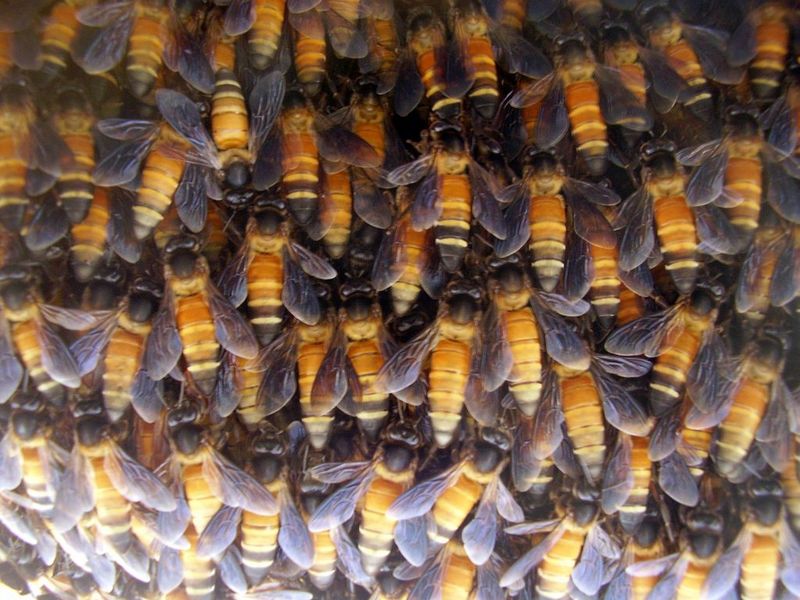| 새로운 사진 | 신문속의 동물소식 | 신기한 동물이야기 | 동물의 소리 | 동물동화상 | 사진 올리기 | 사진 저작권 | English |
|---|
| 재미있는 동물사진 | 괴수/괴어/엽기 동물사진 | 동물이름사전 | 동물목록 | 바깥고리 | 창고입구 | 똑똑누리집 |
|---|
| 이미지 정보 | Original File Name: Giant Honey Bee (Apis dorsata) Hive - Honeybee.jpg Resolution: 1024x768 File Size: 157522 Bytes Date: 2006:10:21 12:34:43 Camera: FE115,X715 (OLYMPUS IMAGING CORP. ) F number: f/3.0 Exposure: 1/2 sec Focal Length: 620/100 Upload Time: 2007:10:09 10:49:46 | |
| 올린이 | 이름 (메일주소): Unknown | |
| 사진 제목 | Giant Honey Bee (Apis dorsata) - Wiki | |
 |
| Email : 카드 | 올린이 | 운영자 사진삭제 정보수정 Admin |
| 설명 | Giant Honey Bee (Apis dorsata) - Wiki
Apis dorsata
Apis dorsata, the Giant honey bee, is a honey bee of southern and southeastern Asia. It is only slightly smaller than the Himalayan honey bee. In the wild, they prefer to nest in exposed areas far off the ground, on tree limbs and under cliff overhangs, and sometimes on buildings. They are aggressive bees which have never been domesticated (as they do not use enclosed cavities for nesting), and can be extremely dangerous if the colony is provoked. Each colony consists of a single vertical comb (sometimes approaching a square meter) suspended from above, and the comb is typically covered by a dense mass of bees. When approached, the workers may exhibit a warning posture, and this signal is transmitted to nearby workers that also adopt the posture, thus creating a visible (and audible) "ripple" effect across the face of the comb, in an almost identical manner to an audience wave at a crowded stadium. Despite its aggressive nature, indigenous peoples have used this species as a source of honey and beeswax, a practice known as "honey hunting." Subspecies Engel (1999) recognized the following subspecies: Apis dorsata dorsata; primarily from India Apis dorsata binghami Cockerell; (Indonesian honey bee) from Malaysia and Indonesia Apis dorsata breviligula Maa; from the Philippines Apis dorsata laboriosa Fabricius; (Himalayan honey bee), also in Myanmar, Laos, and southern China. The latter is not distinct morphologically from the nominate, but has different housekeeping and swarming behavior, allowing it to survive at high altitudes. In addition, there has been little gene flow between it and A. dorsata for millions of years; accordingly, some (Arias & Sheppard 2005) argue that it should be classified as a species. Likewise, the southeastern taxon binghami seems also to be distinct. The limits of their ranges in Indochina and the possible distinctness of the geographically distant Philippines population require more study (Arias & Sheppard 2005). However, the use of the taxonomic rank of "subspecies" is typical for geographically discrete populations, so the difference in opinion here is whether or not to recognize the rank of subspecies or not (i.e., no one is disputing that they are distinct lineages, the dispute is over whether to call them "species"). http://en.wikipedia.org/wiki/Apis_dorsata
| |||
| 댓글 |
| |||||||||||||||||||||||||||||||||||||||||||||||||||||||||||||||||||||||||||||||||||||
| 저작권 정보 | 사진의 저작권은 원저작자에게 있습니다. 동물그림창고는 동물관련 사진을 전시할 수 있는 공간만을 제공합니다.사진을 사용하고자 할 경우에는 저작권자와 협의하시기 바랍니다. |
|
|
|
| |||||||
| CopyLeft © since 1995, 동물그림창고. All rights may be reserved. | ||||||||
Stats